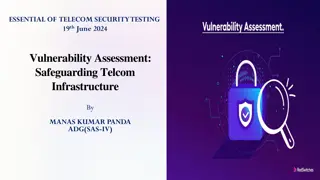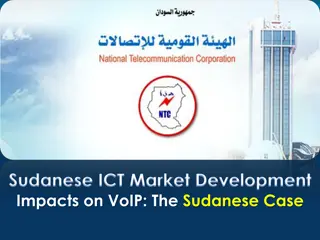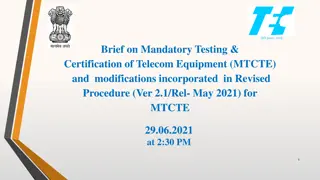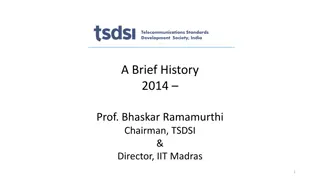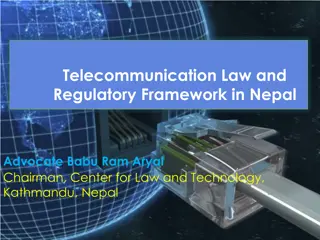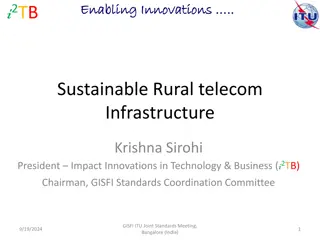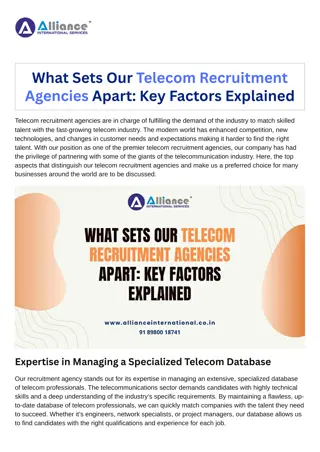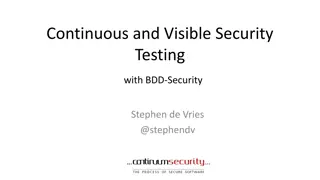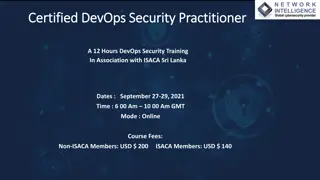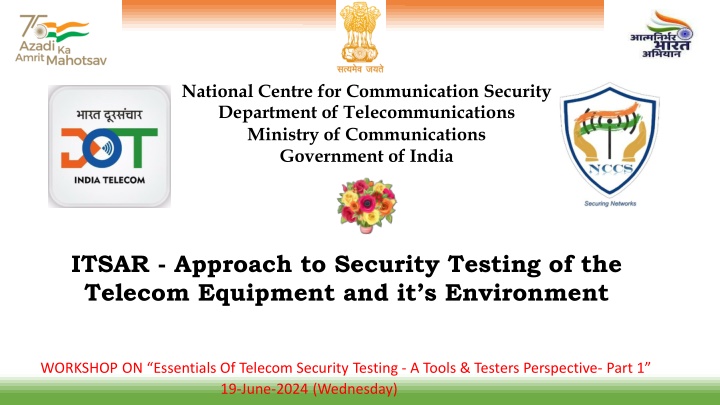
Approach to Security Testing of Telecom Equipment & Environment
The workshop explores essentials of telecom security testing from a tools & testers perspective, covering cybersecurity, telecom network security, and the evolution of information security in the context of protecting digital data.
Download Presentation

Please find below an Image/Link to download the presentation.
The content on the website is provided AS IS for your information and personal use only. It may not be sold, licensed, or shared on other websites without obtaining consent from the author. If you encounter any issues during the download, it is possible that the publisher has removed the file from their server.
You are allowed to download the files provided on this website for personal or commercial use, subject to the condition that they are used lawfully. All files are the property of their respective owners.
The content on the website is provided AS IS for your information and personal use only. It may not be sold, licensed, or shared on other websites without obtaining consent from the author.
E N D
Presentation Transcript
National Centre for Communication Security Department of Telecommunications Ministry of Communications Government of India ITSAR - Approach to Security Testing of the Telecom Equipment and it s Environment WORKSHOP ON Essentials Of Telecom Security Testing - A Tools & Testers Perspective- Part 1 19-June-2024 (Wednesday)
Contents Overview of Cybersecurity Importance of Telecom Networks Security Security Framework for Telecom Regulatory Framework ComseC scheme ITSARs TSTLs
Overview - Cybersecurity Cyber security definition as per ITU-T X.1205 (04/2008) comprises of - Security safeguards Security concepts Policies Guidelines Risk Recovery Strategy Tools Training management Security is not one size fit for all situation, the needs are unique and different
End to End Security End to end security solution for Telecom Networks can be addressed with layered approach. Further security planes can address specific security challenges Application Services Infrastructure
Evolution of security Information Security Cyber Security Network Security Telecom Network Security
Information Security Protects Information from unauthorised access, disclosure, modification and use. Ensures safety of physical data, analog data and digital data Cyber Security Protects Internet-connected networks and systems from digital attacks Ensures the safety of entire digital data Network Security Protects directories and files in a network of computers against unauthorized access, misuse and hacking Ensures the safety of only transmit data Telecom Network security Structures, techniques, transport protocols, and security measures used to provide integrity, availability, confidentiality and authentication for transmissions over private and public communication networks
Importance of Telecom Network Security Cybersecurity is a concern for Telecom Networks as well Applications are run on top of the layered Networks Present day communication networks need resilient approach as the scope, variety and complexity of current cybersecurity threats are increasing exponentially Telecom Service Providers need comprehensive plans to address security concerns The computing power is moving from Core to Edge making it much more complex to address the security concerns. The emerging technologies like 5G, 6G, Open RAN etc., are generic in nature with open architecture with Commercially Off The Shelf (COTS) devices. The Networks are being deployed in Virtual/ Cloud Environment. 5G is the first generation massive Machine Type Communication (mMTC) technology (IoTs, Drones, Smart City Gadgets etc.) Use cases like Health sector, Power, Agriculture, Industry 4.0, Smart City etc., will heavily depend on 5G and beyond technologies
Security Framework for Telecom NDCP-2018 proposes to address the security concerns of the country through development of security standards for Telecom Equipment and Devices and permit the deployment of only the safe and certified equipment To realize this objective, NCCS & TEC have been mandated to develop standards, testing and certification eco system in the country
Regulatory Framework A regulator for Telecom & Broadcasting sectors i.r.o tariff, quality of service, consumer protection etc., with a recommendatory role for introduction of new services, spectrum allocation, and other subjects referred to TRAI by GoI from time to time Addresses the safety and security of Telecom Networks/ products through its wings -Telecom Engineering Centre (TEC), National Centre for Communication Security (NCCS) and other Field Units (LSA, WMO, CCA etc.) Frames the standards viz. Essential Requirements (ERs) but also to develop the eco system for testing and certification of Telecom Equipment Frames the standards viz. Indian Telecom Indian Telecom Security Assurance Requirements (ITSARs) but also to develop the eco system for testing and certification of Telecom Equipment
OBJECTIVES OF NCCS Developing Indian Telecom Security Assurance Requirement (ITSAR), Test Schedules Test procedures (TSTP) for Telecom Equipment. Designating Telecom Security Testing Laboratories (TSTLs) for testing ITSARs and TSTPs. Oversight of testing performed by the designated TSTLs and evaluation of the test results from TSTLs. Issuing security certificate for the successfully tested Telecom Equipment.
Communication Security Certification Scheme (ComSeC)
Background UNIFIED LICENSE The LICENSEE shall induct only those network elements into its telecom network, which have been got tested as per relevant contemporary Indian or International Security Standards e.g. IT and IT related elements against ISO/IEC 15408 standards, for Information Security Management System against ISO 27000 series Standards, Telecom and Telecom related elements against 3GPP security standards, 3GPP2 security standards etc. The certification shall be got done only from authorized and certified agencies/ labs in India or as may be specified by the Licensor.
MTCTE SCHEME In exercise of the powers conferred by section 7 of the Indian Telegraph Act, 1885 (13 of 1885), the Central Government amended the Indian Telegraph Rules, 1951 to insert Rule 528 to 537 in Part XI under the heading Testing & Certification of Telegraph on 05-09- 2017 to be effective from 01-10-2018. The new rules provide that every telecom equipment must undergo prior mandatory testing and certification. TEC has come out with the Procedure for Mandatory Testing and Certification of Telecommunication Equipment (MTCTE) in Oct 2018 to implement these rules.
MTCTE SCHEME Essential Requirements specified: 1. EMI/EMC 2. Safety 3. Technical requirements 4. Other requirements. Will be handled by TEC 5. Security requirements will be handled by a separate unit in DoT (NCCS)
Communication Security Certification Scheme (ComSeC) Mandatory testing and certification in respect of Security requirements is being implemented through a Scheme titled Communication Security Certification Scheme (ComSeC). Objectives of the scheme To develop country specific security standards, processes and specifications To develop testing and certification eco-system. To ensure Telecom network elements meet security assurance requirements. To ensure compliance of regulatory requirements pertaining to security testing
Communication Security Certification Scheme (ComSeC) The scope of certification covers all types of telecom equipment to be sold in India and to be connected to Indian telecom network, after the date of effect of this scheme, for which ITSAR is available and is in force. National Centre for Communication Security (NCCS) is responsible for implementation of this scheme. NCCS is headed by Sr.DDG who is also the Scheme Controller Sr.DDG/ Scheme Controller is assisted by three divisions each headed by a DDG- Security Assurance Standards (SAS) Division Security Lab Recognition/Designation (SLR) Division Security Certification (SC) Division
Communication Security Certification Scheme (ComSeC) Scheme provides for: Preparation and publication of various process documents for the three division of NCCS to carry out their tasks. Preparation and publication of ITSARs based on country specific security requirements, International Standards and consultations with stakeholders such as OEMs, TSTLs, TSPs, Academic institutes, Industry and Government bodies. Designation of Labs as TSTLs after satisfactory evaluation of their application and competency of the lab to perform the security testing as per ITSAR. The labs from private and public sector can be designated as TSTLs .
Communication Security Certification Scheme (ComSeC) Scheme also provides for: Issue of Security Certificate for a Telecom equipment after evaluation of test results submitted by TSTL chosen by the applicant viz., OEM, TSP, Importer etc. Certificate is valid for 10 years or till the equipment is modified, whichever is earlier. Renewal and modification of certificates issued to TSTLs and the equipment. Issue of temporary certificates to facilitate quick deployment of software patches like updates and upgrades. Collection of fee for designation of TSTLs and certification of equipment. Contd
Communication Security Certification Scheme (ComSeC) Scheme also provides for : Dispute resolution mechanism for various process under the scheme. Surveillance to ensure compliance to scheme requirements. Dealing with non-confirmity and contraventions.
Security Testing Framework Policy Formulation Other Ministries Research Institute DRDO DOT MeiTY Scheme Controller Sr DDG NCCS SAS Division ITSAR Policy Pronouncement Policy Lab Recognition Certification Division Security Certification Division Implementation Policy Execution Test Lab - 3 Test Lab - 1 Test Lab - 2 Vendor - Telecom Vendor - Mobile Vendor 4G MTCTE(SC Portal) Single Window
Security Certification Process 1. 2. 3. Preparation and publishing of equipment specific ITSAR. Designation of TSTLs by NCCS as per designation scheme. Applicants intending to get their equipment certified will register on MTCTE portal. After registration, the Applicant can choose a designated TSTL for security testing of his equipment against the applicable ITSAR. TSTL will conduct the requisite testing under the supervision of a validator from NCCS. After completion of the testing, test reports will be submitted by the TSTL for evaluation and security certification by NCCS. On successful evaluation, security certificate will be issued. implement a Single Window System for the implementation of ComSeC scheme. 4. 5. 6. 7. Security Certification portal is being developed and existing MTCTE portal is being modified to
Certification process flow Registration of Applicant and Submission of Application form through MTCTE portal APPLICANT TEC Corrective Action by Applicant Processing and scrutinization of Application Acceptance of Application and documents by TEC Payment of Applicable fee Applicant Chooses the designated TSTL in Portal SC Division TSTL TSTL accepts the request SC Division receives notification of acceptance Appointment of Validator Participation by Validator TSTL starts the security testing against corresponding chosen requirement Submission of Security testing Report Evaluation of Report and Acceptance Issue of Certificate
TSTL Designation Process Prospective TSTL Has capability to test Telecom equipment Accredited by NABL for ISO/IEC 17025 (IT & Software discipline) Submits Application along with supporting documents Evaluation of Application by DA Applicant is informed about Discrepancies/ Deficiencies On-site Assessment Applicant submits compliance to Discrepancies/ Deficiencies Final Review DA issues Designation Certificate
Indian Telecom Security Assurance Requirement (ITSAR)
ITSAR PROCESS Time period SN Activity Description Time in weeks Remarks 1 Input Request stage Inputs from other Ministries (MHA etc.) 2 Study of Standards/ Literature Refer national, International standards, product literature available publicly 6 3 Pre-Consultation Consult Industry for taking their suggestions on security outline document. 4 Draft Preparation, use of applicable standards Scope the security areas and develop requirements for each area 4 5 Stakeholder consultation Notify at NCCS, TEC, DOT websites, collate submissions and conduct meeting 4 6 ITSAR Technical Committee (ITC) Review Circulation, Presentation, incorporating committee recommendations 3 7 ITSAR Approval & Publication Sr.DDG approval post scrutiny 1 Time required may vary from 16 weeks to 24 weeks depending on type of NE Average Time 18 weeks
DETAILS OF ITSARs PUBLISHED S No Category NEs/NFs for which ITSARs published No of NEs/NFs User Plane Function (UPF) Session Management Function (SMF) Unified Data Management (UDM) Network Repository Function (NRF) Network Data Analytics Function (NWDAF) Service Communication Proxy (SCP) Security Edge Protection Proxy (SEPP) Access and Mobility Management Function (AMF) Authentication Server Function (AUSF) Network Exposure Function (NEF) Non-3GPP Interworking Function (N3IWF) gnodeB (option 2) gnodeB (option 3,4 and 7) Network Function Virtualization (NFV) Short Message Service Function(SMSF) Unified Data Repository (UDR) Application Function (AF) Binding Support Function (BSF) Policy Control Function (PCF) Unstructured Data Storage Function (UDSF) Network Slice Selection Function (NSSF) Location Management Function (LMF) & Gateway Mobile Location Centre (GMLC) Charging Function (CHF) Equipment Identity Register (EIR) Network Slice Admission Control Function (NSACF) UE Capability Management Function (UCMF( 1 5G Network 26
DETAILS OF ITSARs PUBLISHED S No Category NEs/NFs for which ITSARs published No of NEs/NFs Wi-Fi (CPE) Modem Mobile User Equipment Pluggable (U)ICC Optical Network Terminal (ONT) - PON family Broadband Private Automatic Branch Exchange (PABX) Hybrid Set Top Box Mobility Management Entity (MME) Serving Gateway (S-GW) PDN Gateway (P-GW) Policy and Charging Rules Function (PCF) Home Subscriber Server (HSS) E-Node B (4G Access Network Element) 2 CPE 6 3 4G Network 6 IP Router Cell Broadcast centre (CBC) Transmission Terminal Equipment (TTE) Optical Line Terminal (OLT) PON family Broadband 4 Miscellaneous 4 Total 42 Crypto controls applicable for all ITSARs
ITSARs IN PROCESS 1. Draft Under Preparation : a) e-SIM b) Network Next Generation Firewall/ IDS/ IPS c) O-RAN - IITM (O-DU,O-CU,O-RU,RIC) 2. Under Stakeholder Consultation: a) Lawful interception (LI) IITB b) Disaggregated RAN IITM (CU,DU,RRU) c) IoT Devices (Smart Meter, Vehicle tracking device, Feedback device and surveillance camera) d) Revision of Crypto Controls
ITSAR Clauses 2.2.9 Logout function 2.2.10 Policy regarding consecutive failed login attempts 2.2.11 Suspend accounts on non-use Section 3: Software Security 2.3.1 Secure Update 2.3.2 Secure Upgrade 2.3.3 Source code security assurance 2.3.4 Known Malware and backdoor Check 2.3.5 No unused software 2.3.6 Unnecessary Services Removal 2.3.7 Restricting System Boot Source 2.3.8 Secure Time Synchronization 2.3.9 Restricted reachability of services 2.3.10 Self Testing
Telecom Security Testing Laboratories (TSTL) Designation Status
TSTLs TSTLs Designated as on date Designated as on date S.No TSTL Name Product Applied for Date of designation IP Router, Wi-Fi CPE 30.12.2022 1 M/s Accucert Labs LLP , Mumbai IP Router, Wi-Fi CPE 31.08.2023 and 27.12.2023 2 M/s UL India, Mumbai M/s Granite River Labs(GRL), Bangalore IP Router, Wi-Fi CPE 01.12.2023 and 28.02.2024 3 TUV Rheinland IP Router , Wi-Fi CPE 14.2.2024 and May 2024 4 Deltaphi Labs Pvt Ltd IP Router, WiFi CPE 28.03.2024 5 Matrix Shell Technologies Pvt Limited 5G SMF 08.04.2024 6
TSTLs TSTLs Designation in progress Designation in progress S.No TSTL Name Product Applied for Tentative Dates M/s CN Labs IP Router and Wi-Fi CPE June, 2024 1 ONT June 2024 2 M/s GRL OLT July 2024




